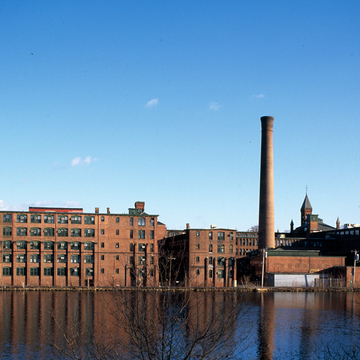This huge, fantastical brick industrial complex grew by accretion from the site's selection in 1854 through a series of Queen Anne and Romanesque Revival additions in the late nineteenth century. The watch factory has a seeming symmetry along the 980-foot Crescent Street arcaded frontage that is belied by the plan. Narrow 100-foot-long, two-story manufacturing rooms extended behind monitored three-story central blocks and two-story clerestoried wings of the original facade. Rear additions along the Charles River created quadrangles with separate rooms for the many individual processes. Largely rebuilt in 1879, the complex has 3,300 windows, five acres of flooring, and several huge smokestacks. The main blocks are four stories above a full basement, towered and turreted above
This important industrial megastructure was one of several places where mass production began—the first company in the United States to adopt the modern factory system of interchangeable parts to watch making. Aaron L. Dennison, a Boston mechanic, first conceived of making watch parts by machines of his own design. His success and the continued growth of this “Palace of Industry” was a major force in Waltham's urban development. Dozens of new machines were invented here to replace hand watch dial making, gilding, and jewelling. By the 1930s the company employed two thousand hands and ran its own training school. After World War II the company fell on hard times and was liquidated in 1957; the property continues to serve industrial users.


